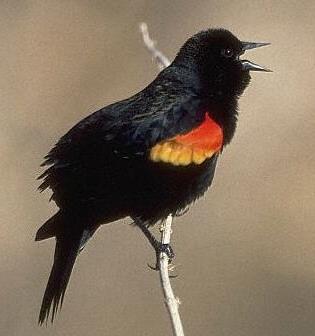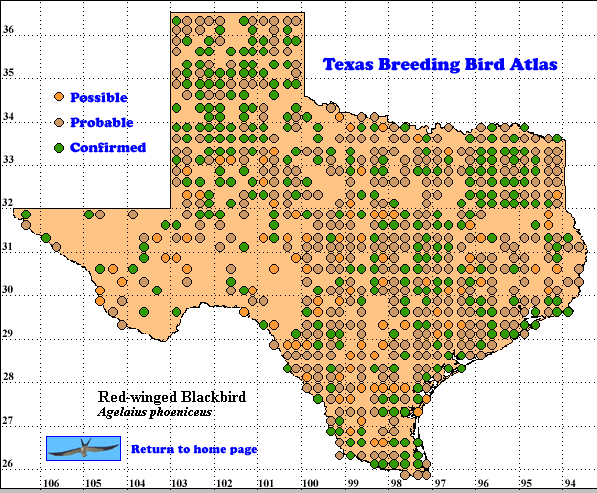Black Bird With 2 Orange Stripe on Wing
 Agelaius phoeniceus
Agelaius phoeniceus
Red-winged Blackbird is a common and conspicuous breeding resident of much of Texas, even more widespread in winter when migrants arrive from further north.
ales and females of this species differ strikingly in plumage, not unusual for blackbirds and orioles.
Females of all ages are mottled brown above and heavily streaked below with a white eyebrow stripe. Third-year and older females are variable in throat (pink to buffy) and epaulet (dull orange to bright orange-red) color. Second year females are duller in these two areas. Since almost all females two-years or older breed, plumage details do not appear to matter to males, many of which are polygamous.
Third-year and older males are glossy black with red "epaulets" bordered in yellow, while second-year males are highly variable, ranging from a female-like plumage to black with brown flanks and variably colored epaulets. No other species in Texas should be confused with Red-winged Blackbirds. For further plumage details and confusing subspecies taxonomy see Yasukawa and Searcy (1995) and Pyle (1997).
Males are often polygamous and vigorously defend territories, containing up to 15 nests, against other Red-winged Blackbirds. While almost all females breed in the second year of life, most males do not become territory holders until their third or later year, when they have acquired the glossy, black plumage with red "epaulets" on their wings. They spend their pre-breeding years as "floaters" around colonies, waiting for a territory to become available (Yasukawa and Searcy 1995).
Red-winged Blackbird is especially conspicuous in winter when the species gathers in sometimes enormous flocks with other blackbirds, grackles and cowbirds to forage on weed seeds, grain spilled at harvest or at cattle feedlots. Feeding flocks in fields may move in a pattern with birds at the rear flying over the flock to alight in front. The flock forages on seeds and insects. Flocks moving between feeding area and roost sites are often of impressive size (Oberholser 1974).
Many of the roughly two dozen recognized subspecies of Red-winged Blackbird either reside or winter in Texas. Although the species varies in size and slightly in plumage across its range in the United States, Canada and Mexico, the number of subspecies appears excessive, and further study is needed, as the evidence provided for separating populations seems inadequate. Yasukawa and Searcy (1995) and Pyle (1997) provide description and ranges of currently assigned subspecies.
DISTRIBUTION. During the 1987-1992 field work for the TBBA project, atlasers found Red-winged Blackbirds breeding most commonly in Texas east of the 100th meridian and throughout the Panhandle. West of this meridian and south of the 32nd parallel, breeding sites in the Trans-Pecos and Edwards Plateau regions are more widely scattered.
In winter migrants from the north increase the population of this species in Texas, but the size and composition of mixed species flocks in which Red-winged Blackbirds are found in winter is difficult to measure even at night roosts.
SEASONAL OCCURRENCE. TBBA workers found Red-winged Blackbirds engaged in breeding activities from March 17 to July 26. Oberholser (1974) reported egg dates extending from April 17 to July 19. The atlasers reported nest building occurring from March 17 to June 25 (most dates in May), nests with eggs May 16 to July 6, female on or near nest May 1 to July 17, nests with young April 8 to June 25, feeding of nestlings or fledglings April 8 to July 28, and recent fledglings May 8 to July 26,
BREEDING HABITAT. Red-winged Blackbird breeds from sea level to 1200 m (4000 ft) in loose colonies in freshwater marshes, wet meadows, stream-side bushes, swamps, pastures, and floodplains. Nests are often placed in cattails or other marsh vegetation or in Baccharis bushes. They may also be found in trees as high as 12 m (40 ft) above ground.
Nests, built in 3-6 days by the female, are bulky, substantial, woven baskets, built of strips of grass, rushes, sedges, reeds, plant stems, or leaves, and lined with finer materials. The female usually lays 4 bluish-green eggs (range 2-6; see Harrison [1979] for photo of markings). Incubation lasts about 11 days (range 10-12) and 2 broods per season are frequent. (Oberholser 1974, Harrison 1979).
STATUS. In the breeding season Red-winged Blackbird is abundant to locally uncommon in most parts of Texas. In the non-breeding season (late July to late April) the species is locally abundant to common in all parts of the state (Oberholser 1974, Lockwood and Freeman 2004).
Breeding Bird Survey (BBS) data for Texas show relative abundances of Red-winged Blackbirds (birds per 40 km [25 mi] route) ranging from above 100 along the Gulf Coast and part of the South Texas Brush Country to 30-100 in the Panhandle, 10-30 in the Post Oak Savannah and Blackland Prairie region and decreasing through other areas to<1 bird per route in the southeastern part of the Trans-Pecos (Sauer et al. 2004).
BBS data for Texas also show a statistically significant decline of 1.62% per year for the period 1966-2003, larger than the United States and Canada trend of -1.0%. The 165 BBS routes on which Red-winged Blackbirds were detected in Texas represent about 4%of the3681 routes reporting this species in the United States and Canada. This suggests Texas has about 4% of the breeding habitat for Red-winged Blackbirds north of the Mexican border (Sauer et al. 2004).
Although the population size appears to be slowly declining, birdwatchers in Texas should continue to see and hear this widespread and common species in the state, especially because migrants from the north enlarge the winter population. Text by Robert C. Tweit (2006)

Literature cited:
Harrison, H. H. 1979. A field guide to western birds' nests. Houghton Mifflin, Boston, MA.
Lockwood, M. W. and B. Freeman. 2004. The TOS handbook of Texas birds. Texas A&M University Press, College Station.
Oberholser, H. C. 1974. The bird life of Texas, Vol. 2. University of Texas Press, Austin.
Pyle, P. 1997. Identification guide to North American birds, part 1. Slate Creek Press, Bolinas, CA.
Sauer, J. R., J. E. Hines, and J. Fallon. 2004. The North American Breeding Bird Survey, results and analysis 1966-2003. Version 2004.1. USGS Patuxent Wildlife Research Center, Laurel MD (Web site, http://www.mbr-pwrc.usgs.gov/bbs).
Yasukawa, K., and W. A. Searcy. 1995. Red-winged Blackbird (Agelaius phoeniceus). In The Birds of North America, No. 184 (A. Poole and F. Gill, eds.). The Birds of North America, Inc., Philadelphia, PA.
Black Bird With 2 Orange Stripe on Wing
Source: https://txtbba.tamu.edu/species-accounts/red-winged-blackbird/
0 Response to "Black Bird With 2 Orange Stripe on Wing"
Post a Comment